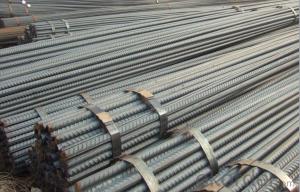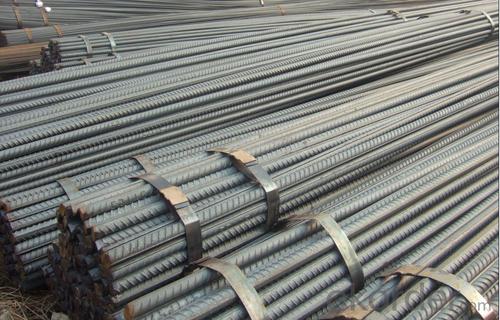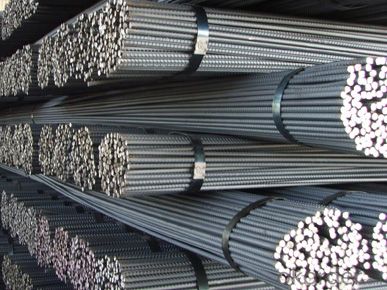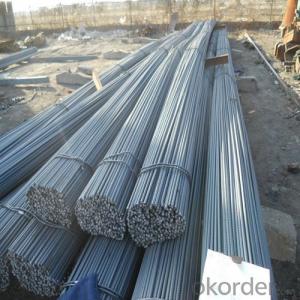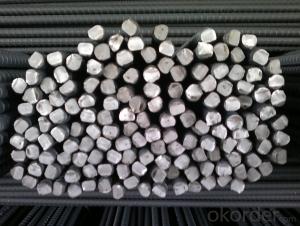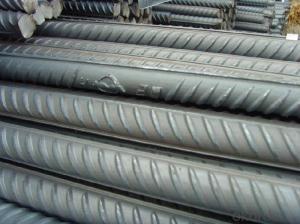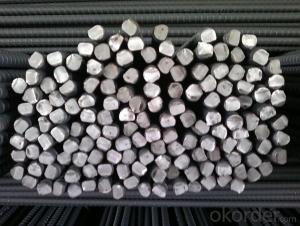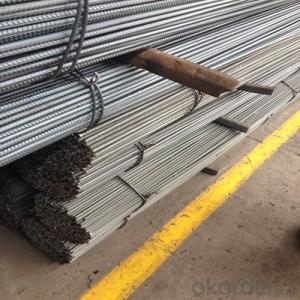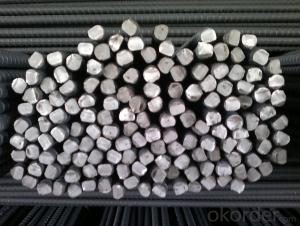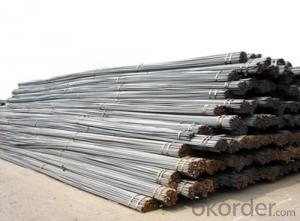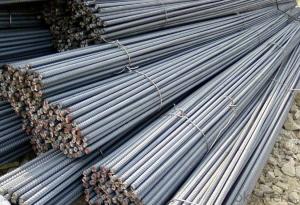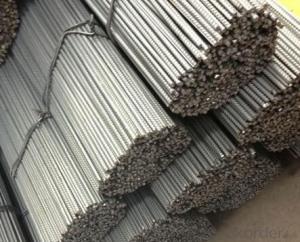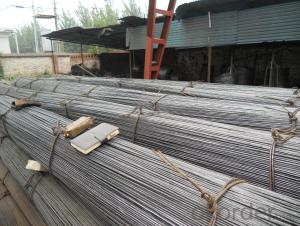Deformed Steel Rebar Straight High Quality
- Loading Port:
- China main port
- Payment Terms:
- TT OR LC
- Min Order Qty:
- 25 m.t.
- Supply Capability:
- 10000 m.t./month
OKorder Service Pledge
OKorder Financial Service
You Might Also Like
Specifications
Standard | GB | HRB400 | |
Diameter | 6mm,8mm,10mm,12mm,14mm,16mm,18mm,20mm, 22mm,25mm,28mm,32mm,36mm,40mm,50mm | ||
Length | 6M, 9M,12M or as required | ||
Place of origin | Hebei, China mainland | ||
Advantages | exact size, regular package, chemical and mechanical properties are stable. | ||
Type | Hot rolled deformed steel bar | ||
Chemical Composition: (Please kindly find our chemistry of our material based on HRB500 as below for your information)
Grade | Technical data of the original chemical composition (%) | ||||||
C | Mn | Si | S | P | V | ||
HRB400 | ≤0.25 | ≤1.60 | ≤0.80 | ≤0.045 | ≤0.045 | 0.04-0.12 | |
Physical capability | |||||||
Yield Strength (N/cm²) | Tensile Strength (N/cm²) | Elongation (%) | |||||
≥400 | ≥570 | ≥14 | |||||
Usage and Applications
Deformed bar is widely used in buildings, bridges, roads and other engineering construction. Big to highways, railways, bridges, culverts, tunnels, public facilities such as flood control, dam, small to housing construction, beam, column, wall and the foundation of the plate, deformed bar is an integral structure material. With the development of world economy and the vigorous development of infrastructure construction, real estate, the demand for deformed bar will be larger and larger..
Packaging & Delivery
Packaging Detail: products are packed in bundle and then shipped by container or bulk vessel, deformed bar is usually naked strapping delivery, when storing, please pay attention to moisture proof. The performance of rust will produce adverse effect.
Each bundle weight: 2-3MT, or as required
Payment term: TT or L/C
Delivery Detail: within 45 days after received advanced payment or LC.
Label: to be specified by customer, generally, each bundle has 1-2 labels
Trade terms: FOB, CFR, CIF
Note
1. Our products are produced according to national standard (GB), if not, supply according to national standards (GB) or agreement as customer required.
2. Other Grade and Standard Deformed Steel Bar we can supply:
Grade: GR40/GR60, G460B/B500A/B500B/B500C,BST500S
Standard: ASTM, BS, DIN
The Minimum Order Quantity of these products is high, and need to be confirmed.
3. We can not only supply Deformed Steel Bar; if you need anything about building materials, please contact us for further information.
4. Please send us your detail specifications when inquire. We will reply to you as soon as possible. We sincerely hope we can establish a long stable business relationship.
- Q: Can steel rebars be used in the construction of government buildings?
- Yes, steel rebars can be used in the construction of government buildings. Steel rebars are commonly used in construction due to their high strength and durability, making them suitable for various building types, including government buildings. They provide reinforcement to concrete structures, increasing their load-bearing capacity and structural integrity, which is essential for the safety and longevity of government buildings. Additionally, steel rebars comply with industry standards and building codes, ensuring that the construction meets the necessary regulations and requirements.
- Q: Can steel rebars be bent without breaking?
- Certainly, steel rebars possess the remarkable ability to undergo bending without experiencing any fractures. These rebars are engineered using an incredibly resilient and durable material known as steel, which boasts exceptional flexibility and tensile strength. Consequently, steel rebars have the capacity to endure substantial bending forces without succumbing to breakage or fracturing. Nevertheless, it is imperative to bear in mind that there exist limitations to the extent to which a steel rebar can be bent without inflicting damage. In the event that excessive force is applied or if the rebar is bent beyond its maximum bending capacity, it may eventually yield and break. Consequently, it is of utmost importance to meticulously adhere to industry guidelines and specifications when manipulating steel rebars, as this guarantees their structural performance and integrity.
- Q: What are the common lengths of steel rebars?
- The common lengths of steel rebars typically range from 6 meters (20 feet) to 12 meters (40 feet).
- Q: How are steel rebars protected from fire damage?
- Steel rebars are protected from fire damage through various methods. One commonly used method is the application of fire-resistant coatings. These coatings are specifically designed to withstand high temperatures and prevent the steel from reaching its critical temperature, which is when it starts to lose its structural integrity. Another method is the use of fire-resistant concrete encasement. In this method, the rebars are embedded within a layer of concrete that has been specifically designed to resist fire. This concrete acts as a barrier, preventing the heat from directly reaching the steel rebars and thus protecting them from fire damage. Additionally, fire-resistant wraps or blankets can be used to provide temporary protection to steel rebars during construction. These wraps are made from fire-resistant materials and are applied directly to the rebars, creating a barrier that prevents direct exposure to fire. It is important to note that the level of fire protection required for steel rebars depends on the specific building codes and regulations in place. These codes typically specify the minimum fire resistance rating that must be achieved for structural elements, including rebars, in order to ensure the safety of the building and its occupants.
- Q: Can steel rebars be used in water storage tanks?
- Yes, steel rebars can be used in water storage tanks. Steel rebars provide structural reinforcement and help to increase the strength and durability of the tank. However, it is important to ensure that the rebars are properly coated or protected to prevent corrosion and contamination of the stored water.
- Q: What are the weight and density of steel rebars?
- Steel rebars, also known as reinforcing bars, are commonly utilized in construction to impart tensile strength to concrete structures. The weight and density of steel rebars may differ depending on their size and grade. The weight of a steel rebar is determined by its cross-sectional area and the specific weight of steel, which is roughly 7850 kilograms per cubic meter (or 0.2836 pounds per cubic inch). The cross-sectional area is usually quantified in square millimeters or square inches. For instance, a prevalent size of steel rebar is the #4 bar, possessing a diameter of 12.7 millimeters (or 0.5 inches) and a cross-sectional area of 127 square millimeters (or 0.197 square inches). By employing the specific weight of steel, we can compute the weight of a #4 rebar in the following way: Weight = Cross-sectional area x Specific weight of steel Weight = 127 mm^2 x 7850 kg/m^3 Weight = 998,950 grams or approximately 998.95 kilograms (or 2,201 pounds) Concerning density, the density of steel rebars coincides with the specific weight of steel, which is roughly 7850 kilograms per cubic meter. This density remains relatively consistent across diverse sizes and grades of steel rebars. It is important to acknowledge that the weight and density of steel rebars may slightly fluctuate based on the precise composition and manufacturing process. It is therefore prudent to refer to the manufacturer's specifications or consult engineering references for precise and up-to-date information.
- Q: Can steel rebars be used in sustainable construction practices?
- Yes, steel rebars can be used in sustainable construction practices. Steel is a highly durable material that can be recycled, reducing the need for new production and minimizing environmental impact. Additionally, steel rebars provide strength and structural integrity to constructions, allowing for longer lifespan and reduced maintenance requirements. By incorporating steel rebars in sustainable construction practices, we can promote resource efficiency and minimize the overall environmental footprint.
- Q: Can steel rebars be used in offshore oil and gas platform construction?
- Yes, steel rebars can be used in offshore oil and gas platform construction. They are commonly used to reinforce concrete structures in these platforms, providing strength and durability to withstand the harsh marine environment.
- Q: What are the limitations of using steel rebars in construction?
- One limitation of using steel rebars in construction is their susceptibility to corrosion. When exposed to moisture and oxygen, steel rebars can rust over time, compromising the structural integrity of the concrete. Additionally, steel rebars are relatively heavy, which can increase the overall weight of the structure and potentially require additional support. Lastly, steel rebars can be expensive, especially in regions where the cost of steel is high, making alternative reinforcement materials more appealing from a cost perspective.
- Q: What are the different types of steel rebars used in industrial constructions?
- The different types of steel rebars commonly used in industrial constructions include mild steel rebar, high-strength deformed steel rebar, epoxy-coated steel rebar, stainless steel rebar, and galvanized steel rebar.
Send your message to us
Deformed Steel Rebar Straight High Quality
- Loading Port:
- China main port
- Payment Terms:
- TT OR LC
- Min Order Qty:
- 25 m.t.
- Supply Capability:
- 10000 m.t./month
OKorder Service Pledge
OKorder Financial Service
Similar products
Hot products
Hot Searches
Related keywords
